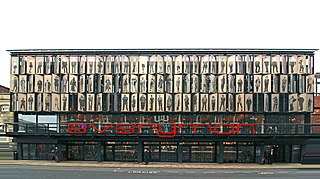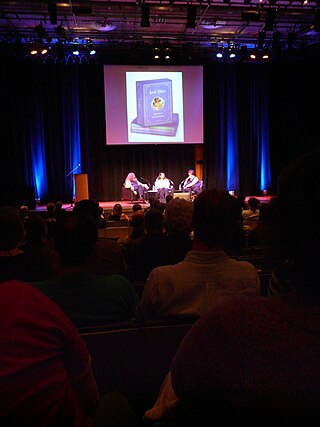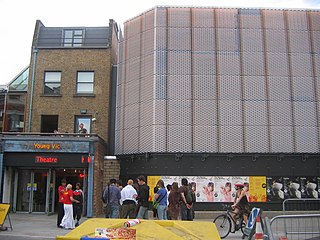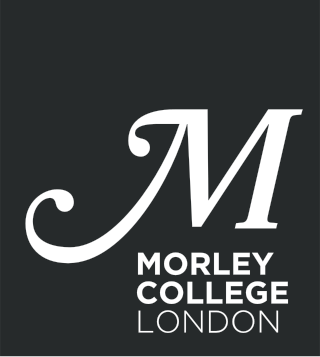
Battersea Power Station is a decommissioned coal-fired power station located on the south bank of the River Thames in Nine Elms, Battersea in the London Borough of Wandsworth. It was built by the London Power Company (LPC) to the design of Leonard Pearce, Engineer in Chief to the LPC, and CS Allott & Son Engineers. The architects were J. Theo Halliday and Giles Gilbert Scott. The station is one of the world's largest brick buildings and notable for its original, Art Deco interior fittings and decor.

The Royal College of Art (RCA) is a public research university in London, United Kingdom, with campuses in South Kensington, Battersea and White City. It is the only entirely postgraduate art and design university in the United Kingdom. It offers postgraduate degrees in art and design to students from over 60 countries.

The South London Theatre is a community theatre housed in a Grade II listed former fire station, in West Norwood in the London Borough of Lambeth, England. The first play opened in October 1967, and it is now a busy theatrical venue, presenting more than 22 shows annually in its theatre space, which was remodelled during refurbishment of the Old Fire Station during the period 2015–2018. The theatre facilities also consist of two dedicated rehearsal spaces, an entire floor of wardrobe rooms and a private basement bar, open Sunday to Friday evenings to audiences and members and which plays host to regular social events.

The Royal Festival Hall is a 2,700-seat concert, dance and talks venue within Southbank Centre in London, England. It is situated on the South Bank of the River Thames, not far from Hungerford Bridge, in the London Borough of Lambeth. It is a Grade I listed building, the first post-war building to become so protected. The London Philharmonic Orchestra, the Philharmonia Orchestra, the Orchestra of the Age of Enlightenment, the London Sinfonietta, Chineke! and Aurora are resident orchestras at Southbank Centre.

Bristol Old Vic is a British theatre company based at the Theatre Royal, Bristol. The present company was established in 1946 as an offshoot of the Old Vic in London. It is associated with the Bristol Old Vic Theatre School, which became a financially independent organisation in the 1990s. Bristol Old Vic runs a Young Company for those aged 7–25.

The Everyman Theatre stands at the north end of Hope Street in Liverpool, Merseyside, England. It was founded in 1964, in Hope Hall, in an area of Liverpool noted for its bohemian environment and political edge, and quickly built a reputation for ground-breaking work. The Everyman was completely rebuilt between 2011 and 2014.

The Queen Elizabeth Hall (QEH) is a music venue on the South Bank in London, England, that hosts classical, jazz, and avant-garde music, talks and dance performances. It was opened in 1967, with a concert conducted by Benjamin Britten.

The Purcell Room is a concert and performance venue which forms part of the Southbank Centre, one of central London's leading cultural complexes. It is named after the 17th century English composer Henry Purcell and has 370 seats. The Purcell Room has hosted a wide range of chamber music, jazz, mime and poetry recitals. In the context of the Southbank Centre it is the smallest of a set of three venues, the other two being the Royal Festival Hall, a large symphony hall, and the Queen Elizabeth Hall (QEH), which is used for orchestral, chamber and contemporary amplified music.

The Young Vic Theatre is a performing arts venue located on The Cut, near the South Bank, in the London Borough of Lambeth.

Nine Elms is an area of south-west London, England, within the London Borough of Wandsworth, with some parts extending into the neighbouring London Borough of Lambeth. It lies on the River Thames, with Battersea to the west, South Lambeth to the south and Vauxhall to the east. Across the Thames is Pimlico.

Coin Street Community Builders (CSCB) is a development trust and social enterprise which seeks to make London's South Bank a better place in which to live, to work, to visit and to study. Since 1984 CSCB has transformed a largely derelict 13-acre site into a thriving mixed-use neighbourhood.

Morley College is a specialist adult education and further education college in London, England. The college has three main campuses, one in Waterloo on the South Bank, and two in West London namely in North Kensington and in Chelsea, the latter two joining following a merger with Kensington and Chelsea College in 2020. There are also smaller centres part of the college elsewhere. Morley College is also a registered charity under English law. It was originally founded in the 1880s and has a student population of 11,000 adult students. It offers courses in a wide variety of fields, including art and design, fashion, languages, drama, dance, music, health and humanities.

The Belgrade Theatre is a live performance venue in Coventry, England. It was the first civic theatre to be built in Britain after the Second World War and is now a Grade II listed building.
Tom Morris OBE is an English theatre director, writer and producer. He was the Artistic Director at BAC from 1995 to 2004 and the Artistic Director of Bristol Old Vic from 2009 to 2022. He has been Associate Director at the National Theatre since 2004.
Emma Stenning is a British arts professional, based in Birmingham, where she is the Chief Executive of the City of Birmingham Symphony Orchestra. She joined the CBSO from Soulpepper Theatre where she was Executive Director from 2018-2022.
The year 2014 in architecture involved some significant architectural events and new buildings.

The Hayward Gallery is an art gallery within the Southbank Centre in central London, England and part of an area of major arts venues on the South Bank of the River Thames. It is sited adjacent to the other Southbank Centre buildings and also the National Theatre and BFI Southbank repertory cinema. Following a rebranding of the South Bank Centre to Southbank Centre in early 2007, the Hayward Gallery was known as the Hayward until early 2011.

Battersea Town Hall, originally the New Parochial Offices, Battersea, is a Grade II* listed municipal building in Battersea, south London, designed by Edward Mountford and erected between 1891 and 1893 by the Battersea vestry to provide public halls and office space for its staff. The building served for 72 years as the hub of municipal Battersea until the centre of local government was moved to neighbouring Wandsworth in 1965, after which it transitioned to use as a community and arts centre, latterly known as the Battersea Arts Centre.
RIBA National Awards are part of an awards program operated by the Royal Institute of British Architects, also encompassing the Stirling Prize, the European Award and the International Award. The National Awards are given to buildings in the UK which are "recognised as significant contributions to architecture" which are chosen from the buildings to receive an RIBA Regional award.















